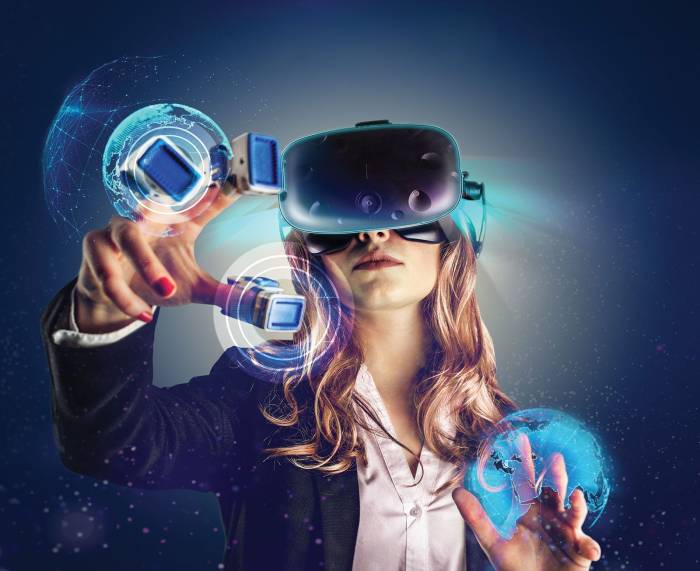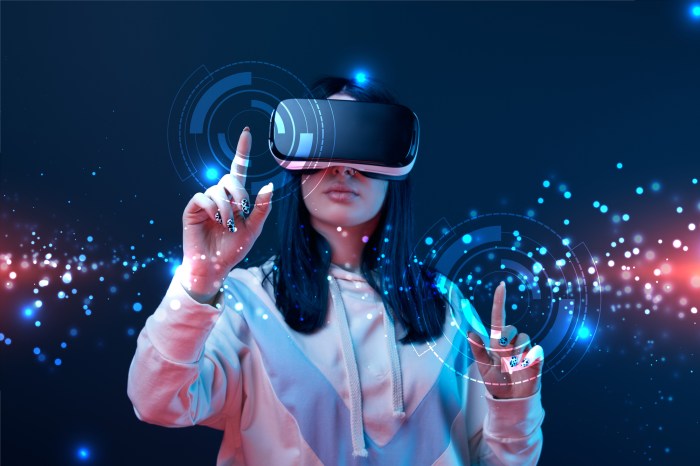Virtual Reality, a technology that transports us to digital realms, has become a captivating force in our world. From interactive gaming experiences to immersive training simulations, VR is revolutionizing how we interact with technology and experience the world around us.
Its origins can be traced back to the early days of computer graphics, but it’s only in recent years that advancements in hardware and software have made VR truly accessible and engaging.
The journey into VR begins with specialized headsets that create a sense of presence within digital environments. These headsets, equipped with advanced displays and motion tracking sensors, allow users to move and interact within these virtual worlds, blurring the lines between reality and simulation.
VR’s potential is vast, spanning industries from entertainment and education to healthcare and engineering. It promises to transform the way we learn, work, and even socialize, creating new possibilities for exploration and connection.
Introduction to Virtual Reality
Virtual reality (VR) is an immersive technology that creates a simulated environment for users, allowing them to interact with it in a realistic and engaging way. It uses computer-generated imagery, sound, and other sensory stimuli to transport users to a virtual world.The core components of VR technology include:
Head-Mounted Display (HMD)
A device worn on the head that displays the virtual environment and tracks the user’s head movements.
Motion Tracking
Sensors that track the user’s movements and translate them into the virtual environment, enabling interaction.
Input Devices
Controllers, hand-tracking systems, or other devices that allow users to interact with the virtual world.
Software
The software that generates the virtual environment, handles user interactions, and renders the visuals.
History and Evolution of VR
The concept of virtual reality has been around for decades, with early ideas dating back to the 1950s. However, the technology has evolved significantly over time.
- Early Beginnings (1950s-1960s):The earliest VR experiences were rudimentary, often involving simple stereoscopic displays or head-mounted devices with limited functionality. Morton Heilig’s Sensorama (1957) is considered one of the first attempts to create a multi-sensory VR experience.
- The Rise of Computer Graphics (1970s-1980s):Advances in computer graphics and processing power allowed for more sophisticated VR systems. The invention of the head-mounted display (HMD) by Ivan Sutherland in 1968 was a major breakthrough.
- Commercialization and Gaming (1990s-2000s):The 1990s saw the first commercial VR systems, although they were expensive and limited in their applications. The early 2000s witnessed the rise of VR gaming, with titles like “Half-Life” and “Doom 3” showcasing the potential of the technology.
- Modern VR (2010s-Present):The development of affordable HMDs like the Oculus Rift and HTC Vive in the 2010s has made VR more accessible to the general public. Advancements in technology have led to more immersive experiences, higher fidelity graphics, and wider applications beyond gaming.
Applications of Virtual Reality
Virtual reality has found applications across various industries, offering unique opportunities for training, education, entertainment, and more.
- Gaming: VR gaming has become a popular genre, offering immersive and interactive experiences. Games like “Beat Saber,” “Half-Life: Alyx,” and “Resident Evil 7” have showcased the potential of VR in creating engaging and thrilling gameplay.
- Training and Simulation: VR provides realistic simulations for training in various fields, including healthcare, aviation, military, and manufacturing. This allows trainees to practice procedures, learn skills, and make mistakes in a safe and controlled environment.
- Education: VR offers interactive and engaging learning experiences, allowing students to explore historical events, visit remote locations, and interact with virtual objects. VR can be used to teach subjects like history, science, and art in a more immersive and engaging way.
- Healthcare: VR is being used in healthcare for various applications, including pain management, rehabilitation, and therapy. VR can be used to create calming environments, distract patients from pain, and provide immersive experiences for therapy sessions.
- Architecture and Design: VR allows architects and designers to create and visualize buildings and spaces in 3D. They can walk through virtual models, explore different design options, and experience the space as if it were real.
- Retail and E-commerce: VR is being used in retail to create virtual shopping experiences, allowing customers to try on clothes, view products in detail, and explore virtual stores. VR can also be used for product demonstrations and training.
VR Hardware and Technology

Virtual reality (VR) technology relies on specialized hardware to create immersive experiences. This hardware encompasses headsets, motion tracking systems, and other components that work together to transport users into digital environments.
VR Headsets
VR headsets are the primary interface for interacting with virtual worlds. They typically consist of a display, lenses, and sensors. Different types of VR headsets cater to various needs and budgets.
- Standalone VR Headsets: These headsets are self-contained devices with built-in processing power and batteries. They offer a wireless experience and are generally more portable. Examples include the Oculus Quest 2 and the Pico Neo 3 Pro.
- PC-Tethered VR Headsets: These headsets require a powerful PC to run VR applications. They typically offer higher fidelity graphics and performance compared to standalone headsets. Examples include the Valve Index and the HTC Vive Pro 2.
- Mobile VR Headsets: These headsets are designed to be used with smartphones. They are typically more affordable and accessible but have limited processing power and display quality. Examples include the Google Cardboard and the Samsung Gear VR.
Motion Tracking and Sensory Feedback, Virtual Reality
Motion tracking is essential for VR experiences to accurately reflect the user’s movements in the virtual world. VR headsets use various technologies for motion tracking, including:
- Inside-Out Tracking: This technology uses cameras embedded in the headset to track the user’s position and orientation. It is typically found in standalone VR headsets and offers a more convenient setup.
- Outside-In Tracking: This technology relies on external sensors placed around the room to track the user’s movements. It generally offers higher accuracy and precision but requires more setup.
Sensory feedback enhances the realism of VR experiences by providing physical sensations to the user. Common types of sensory feedback include:
- Haptic Feedback: This technology provides tactile sensations, such as vibrations, to simulate touch or impact in the virtual world. It can be implemented in controllers, gloves, or even the headset itself.
- Force Feedback: This technology applies physical forces to the user, such as resistance or pressure, to create a more realistic interaction with virtual objects. It is often used in controllers or other peripherals.
VR Display Technology
VR display technology plays a crucial role in determining the visual quality of VR experiences. Advancements in display technology have led to higher resolutions, wider field of view, and improved refresh rates.
- Resolution: VR headsets with higher resolutions offer sharper and more detailed visuals. The resolution of a VR display is typically measured in pixels per eye (PPD). Higher PPD values indicate a more immersive and realistic experience.
- Field of View: The field of view (FOV) refers to the amount of the virtual world that is visible to the user at any given time. A wider FOV provides a more immersive and less “screen-door” effect.
- Refresh Rate: The refresh rate of a VR display determines how many times the image is updated per second. A higher refresh rate reduces motion blur and improves the smoothness of the VR experience.
Applications of VR in Various Industries
Virtual reality (VR) technology has emerged as a transformative force across various industries, offering immersive and interactive experiences that have the potential to revolutionize the way we work, learn, and entertain ourselves. VR’s ability to create realistic and engaging virtual environments has opened up a wide range of possibilities, from enhancing gaming experiences to providing innovative solutions in healthcare, education, and design.
VR in Gaming and Entertainment
The gaming industry has been at the forefront of VR adoption, leveraging its immersive capabilities to create captivating and interactive experiences. VR games offer players a sense of presence and agency, allowing them to explore virtual worlds and engage in activities that were previously impossible.
- Immersive Gameplay:VR games transport players into virtual worlds, enabling them to interact with environments and objects in a more realistic and engaging manner. This enhanced immersion can lead to more engaging and memorable gaming experiences. Examples include games like “Beat Saber,” “Half-Life: Alyx,” and “Resident Evil 7: Biohazard,” which have gained popularity for their immersive gameplay and innovative use of VR technology.
- New Game Mechanics:VR has opened up new possibilities for game design, enabling developers to create unique gameplay mechanics that take advantage of the immersive nature of VR. For instance, games like “Job Simulator” and “Accounting+” utilize VR to create humorous and engaging experiences that wouldn’t be possible in traditional gaming environments.
- Social Interaction:VR has the potential to enhance social interaction in gaming, allowing players to connect with others in virtual environments and engage in shared experiences. Games like “VR Chat” and “Rec Room” provide platforms for social interaction, fostering a sense of community and shared enjoyment among players.
Beyond gaming, VR is also making its mark in the entertainment industry, offering innovative ways to engage audiences.
- Virtual Concerts and Events:VR concerts and events allow audiences to experience live performances from the comfort of their homes, providing a sense of presence and immersion that traditional live streaming cannot match. Companies like Live Nation and MelodyVR are pioneering the use of VR in live entertainment, offering virtual concert experiences that are both immersive and interactive.
- Interactive Storytelling:VR can enhance storytelling by allowing audiences to become active participants in the narrative. VR experiences like “TheBlu” and “The Martian VR Experience” provide immersive and engaging storytelling that transports viewers to different worlds and allows them to interact with the story in unique ways.
Future Trends in VR Technology

Virtual reality (VR) technology is rapidly evolving, and its potential applications are expanding beyond entertainment into various industries. The future of VR holds exciting possibilities, driven by advancements in hardware, software, and emerging technologies like augmented reality (AR) and mixed reality (MR).
The Convergence of VR, AR, and MR
The lines between VR, AR, and MR are blurring as technologies converge.
- Augmented reality (AR)overlays digital information onto the real world, enhancing our perception of reality. Examples include AR games like Pokémon Go, where virtual creatures appear in the real world, and AR navigation apps that provide real-time directions overlaid on the user’s view.
- Mixed reality (MR)blends the physical and digital worlds, allowing users to interact with both real and virtual objects simultaneously. For example, in an MR environment, a user could collaborate with a virtual colleague on a project in a shared physical space.
This convergence is creating new possibilities for immersive experiences, bridging the gap between the virtual and real worlds.
Final Review
As VR technology continues to evolve, its impact on our lives will only grow. From immersive entertainment experiences to transformative applications in healthcare and education, VR is poised to shape the future in profound ways. It’s a technology that invites us to explore new frontiers, challenge our perceptions, and connect with the world in ways we never thought possible.
As we delve deeper into the realms of virtual reality, we can expect to witness innovations that push the boundaries of what we consider real, blurring the lines between the physical and the digital.
FAQ
What are some common examples of VR applications?
VR applications are widespread, ranging from immersive gaming experiences like “Half-Life: Alyx” and “Beat Saber” to educational simulations that allow students to explore historical events or perform complex surgeries. In healthcare, VR is used for pain management, rehabilitation, and even surgical training.
Is VR safe for everyone?
While VR offers incredible experiences, it’s important to use it responsibly. Some individuals may experience motion sickness or eye strain, especially during prolonged use. It’s crucial to follow recommended guidelines for usage and take breaks when needed.
How much does VR equipment cost?
The cost of VR equipment varies widely depending on the specific headset, controllers, and other accessories. Entry-level headsets are relatively affordable, while high-end systems with advanced features can be more expensive.
